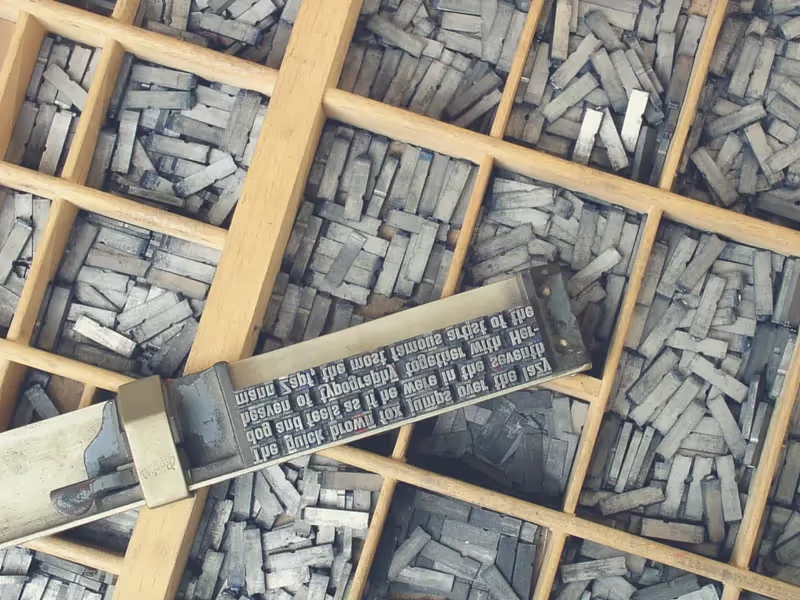Design
Looking for inspiration, design tricks, how to make a great cover, promoting your yearbook and engaging your community?
Most recent

3 content ideas for portrait pages
When “outsiders” think of yearbooks, they imagine little beyond the portrait pages. They see the obligatory blue background and big grins that accompany a moment in time many of us, as students, dreaded. (C’mon, we all didn’t receive the Glamor Shots by Deb experience!) Since this is a part of students’ permanent record, it's a necessary component. It is a part of the historical record of the school year. It’s also not our students’ favorite. Long ago, this adviser decided to decrease the size of yearbook portraits, while increasing specialized content. Here are three ideas to break up your portrait pages by adding rich, personal content.
1. By the Numbers
Use stats and surveys to provide a quantifiable portrait of the students pictured on your pages. Begin by understanding what is important to your students and then ask questions. For example, if your school’s focus is on health and wellness, break down how students and staff contribute to that goal by including content such as
Pair the numbers with photographs of students engaging in the activities and quotes for an even more personal approach. What does it mean to be a part of a community so encouraging of physical activity? How do students balance their school work with tournaments and performances?

2. Keep Content Class-y
Grade spreads in your portrait section are ideal for academics or class-specific coverage. Highlight the unifying aspects of school life, such as class trips or advisory periods, and then ask students about their individual experiences with each. Grade sections could also include:
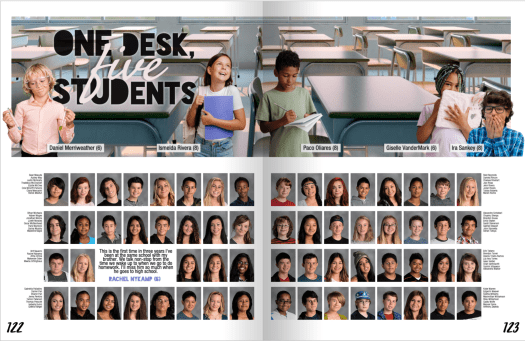
3. Get Personal with Portraits
Personality profiles and student life modules both create opportunities for an inclusive yearbook by targeting lesser known students or students with interests outside school-sponsored arts and athletics. These content modules add voices to the portrait section of your yearbook!

Take advantage of the additional space you'll create by shrinking portraits to pull out more content from your student body.

10 reasons we're excited about TRL
Recreating the wheel is exhausting. Having Treering Live (TRL) experts provide all their tips and tricks saves time and energy and brings the fun back to yearbooking. (Yes, yearbook is a verb.) Treering tailored TRL for yearbook volunteers, educators, and aficionados of all levels, offering 18 sessions so you can engage with various aspects of the creative process. In anticipation, we compiled our top reasons TRL is the yearbook event of the season.

1. Leave with a road map
Figuring out how to get started when you're new to the school yearbook is daunting, especially when the person who used to do it is no longer at the school. Learn how to start and finish your yearbook.
Recommended sessions: I’m the Yearbook Coordinator… Now What? and Teaching Yearbook
2. Live event
Real-time sessions mean your questions get asked and answered promptly. Between the live Q&A during each session and the chat throughout, there are plenty of opportunities for shared learning.
Recommended sessions: Ask Us Anything with Treering’s Co-Founder Brady McCue and Keep, Change, Stop
3. Connecting with other advisers
Because two—or four hundred—heads are better than one, working together turns terrifying yearbook mountains into easy-to-approach small hills. TRL is not just about knowledge acquisition; it's about building connections within the yearbook community during National School Yearbook Week. You'll collaborate with fellow yearbook enthusiasts, sharing your triumphs, learning from your challenges, and forging bonds beyond these three days online.
Recommended sessions: Fundraising and Crowdsourcing and Social Media for Yearbook
4. Making a plan
From a ladder and coverage calendar to the next marketing campaign, you’re leaving TRL with concrete steps to make the best yearbook yet.
Recommended sessions: Getting Organized and Creating a Marketing Plan
5. Design inspiration
Yearbook Hero Lauren Casteen introduced us to mild, medium, and spicy design. Wherever you fall on this scale, you will gain an understanding of layout, typography, and color and how to go to the next level. You’ll also be able to help your yearbook team produce robust designs. Because, seriously, no one should yearbook alone.
Recommended sessions: Design 101 and Design 201
6. Three days of training
Joining TRL for one or all 18 sessions is a testament to your passion for preserving the memories and historical record of the school year, one page at a time.
7. cash
Kind of. Because we love a theme, there will be some sort of game in many sessions. Prizes include pizza parties, art supplies, and gift cards for coffee or Amazon.
8. 6+ hours of PD
Treering loves teachers. You’ll see learning outcomes in the session descriptions, and some of us, unabashedly, speak in teacher-ese. We know the importance of pro-grow opportunities. We know how annoying it is when someone reads their slides.
9. The Treering difference
Many schools consider changing their yearbook program and need to see Treering’s software firsthand. Busy schedules make it difficult, so we have four opportunities to dive in.
Recommended session: Live Demo
10. The journey isn’t over
In keeping with our game theme, your next winning move can take the form of weekly posts on the blog, monthly webinars, and 24/7 support with the Help Center. These myriad options allow flexibility in scheduling and enable you to revisit content or learn something new at your own pace.
Share your top moments during TRL: 23 by tagging us on social using @treering (Facebook and X) or @treeringcorp (Instagram and TikTok) using #trl23.

Never yearbook alone
This is the heart of Treering’s Yearbook Club webinars. Teachers looking for classroom support and parent volunteers looking for a launch pad can find resources and how-tos throughout the school year at no cost.

Synchronous instruction
If you don’t speak teacher-ese (or don’t care to on your prep period), this just means it’s live. This real-time interaction means attendees receive instant responses to their questions. (Full disclosure: occasionally, we divert from the script because the group’s needs demand it.)
Direct access to expertise
See what happens when you bring together staff members from product knowledge, marketing, and community advocacy. No PowerPoint slides. No hypotheticals. All yearbook.
We believe in show and tell
Starting at Treering.com, every webinar shows you how to create, get inspiration, and receive help. We show you how to customize your styles and settings, find marketing materials, and maximize the automations in Treering’s yearbook builder.

Each month, new advisers can join a Getting Started webinar to get an overview of the design and print process. As you progress through your yearbook journey other webinars are available, including Treering Live, our flagship virtual yearbooking event and topical sessions on portrait, advanced design, and theme development.
Your yearbook your way
Yearbook creation isn’t a one-size-fits-all process. Neither are Yearbook Club webinars. We’ll show you all your options to make your yearbook represent your population, from changing up backgrounds to creating custom word art.
The Yearbook Club team releases new Tip Tuesday videos each week on YouTube.
Community
Call it networking, if that’s your thing. In the live chat, attendees exchange ideas and strategies.
On a personal note, I’ve met some yearbook advisers in the chat who have become contributors to this blog, and I’d like to think lifelong friends. We celebrate professional and personal milestones together. Occasionally, family pics pop into my inbox, or we text a timely yearbook meme.
No one else understands what being a yearbook coordinator is like outside this small world. I’m going to seek support from those who do.
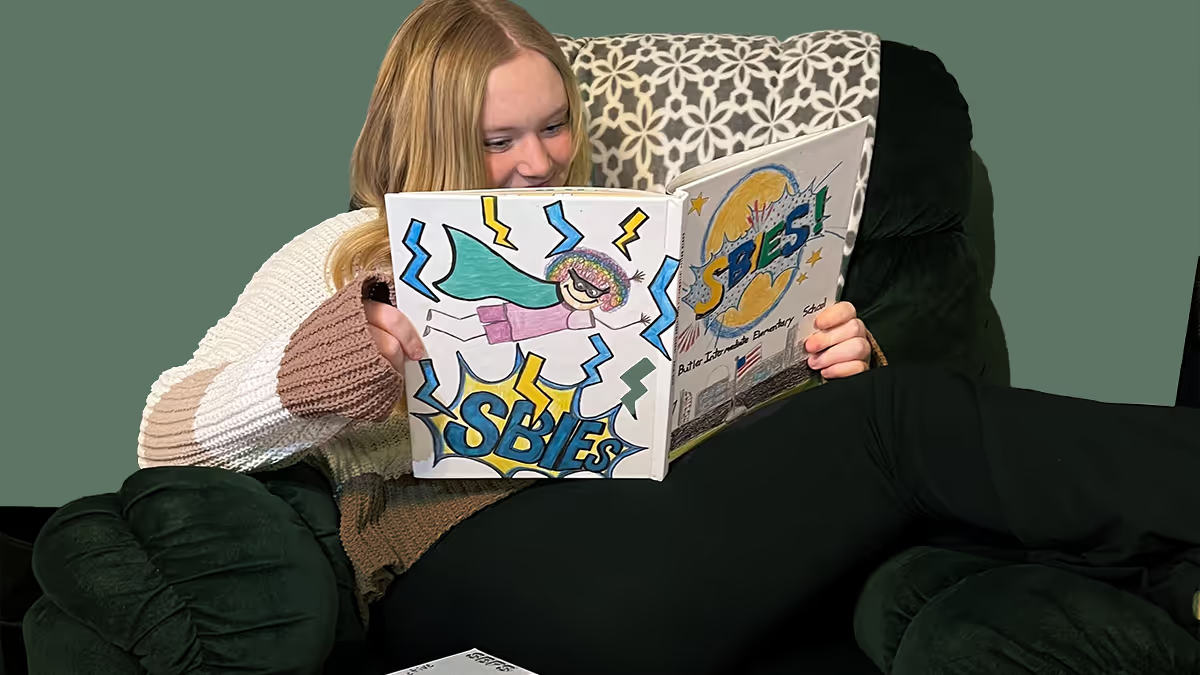
Creating custom yearbook covers with student art
It’s fall, and we’re all going crazy about yearbook themes. After your team decides on the collective story to tell, consider how you will communicate it visually. If you haven’t yet, use student art on the yearbook cover to celebrate and showcase the diverse talents of the student body. It adds a unique, only-on-our-campus touch, which we love. After all, customization is our thing.
Custom cover advice from the pros
The Treering Design Team helps roughly 200 schools annually with their cover issues. The biggest piece of advice: make sure you have enough bleed. This keeps art from being cut off in the scanning process. We always say to get those printed proofs ordered early; this is one more reason.
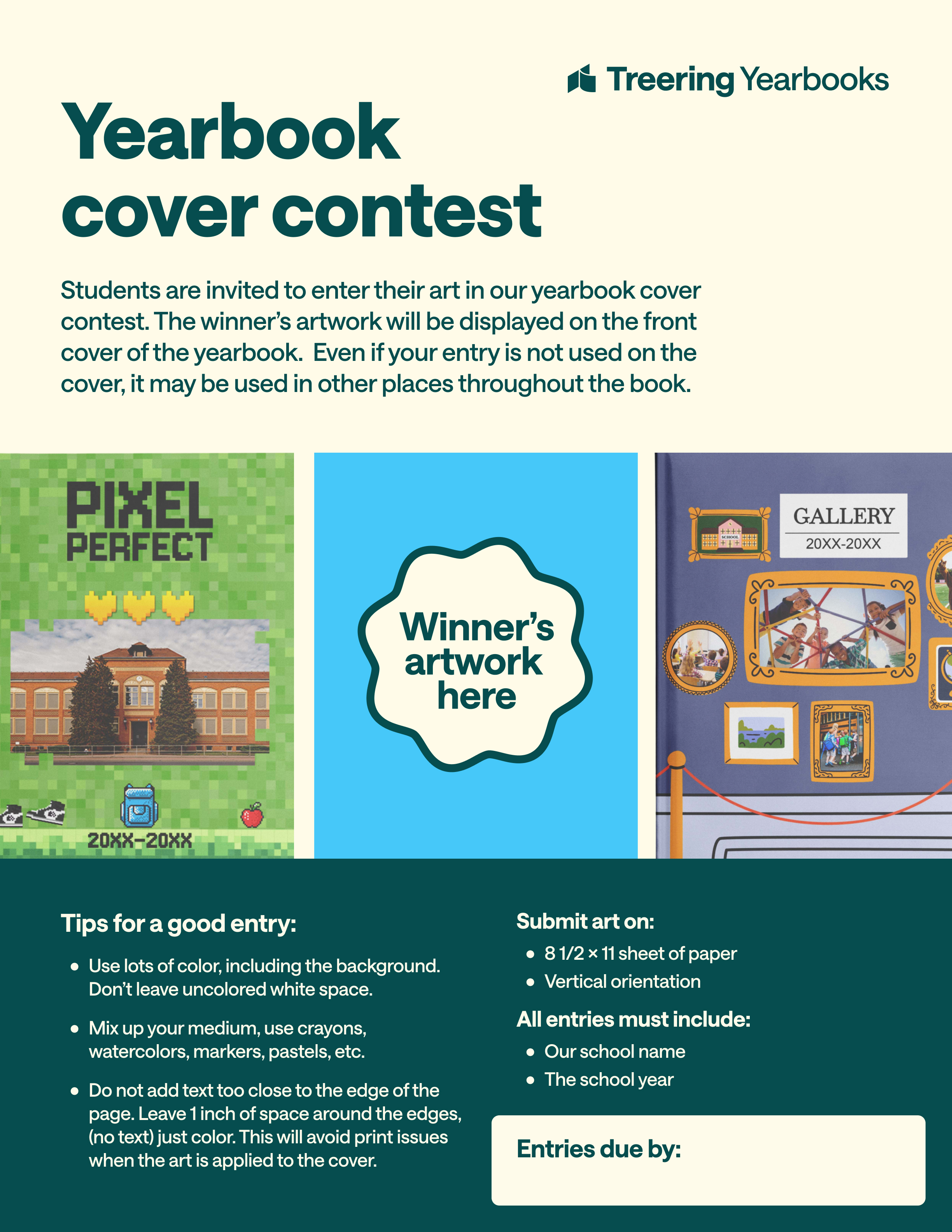
They also suggest advisers understand the technical requirements so your art prints sharply and vibrantly:
- Scan the page at 300 DPI or higher
- Save it as a JPG or PNG
- Upload the image to Treering as a photo
Ideas for gathering student art
Student art is that simple: it’s art from students. Whether you source it through an intra-campus partnership or create a school-wide drive, the goal is to achieve a personal, unique-to-us impact.
Cover collaborations
Class projects, such as collaborations with art teachers, get students outside the yearbook room involved. (And really, this is marketing gold: you’re building a relationship with a group who are now stakeholders in your final project.)
Yearbook volunteer Lauren D. shared how they went from classroom to yearbook cover with an art project at Normandale Elementary. The art teacher used batik patterns made by her students into creatures for their yearbook cover.
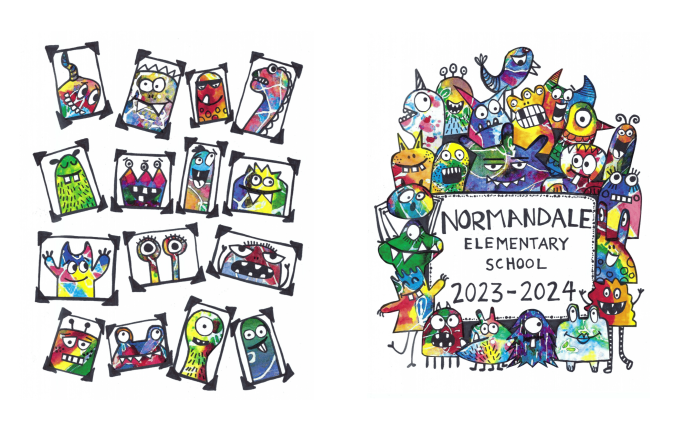

How to do a yearbook cover art contest
“I believe that students should be the driving force behind the yearbook's design,” said yearbook Adviser Julie R. She uses a cover contest to showcase student art. She asks students to use school colors and to “represent what learning and school look like to them.” Her yearbook team looks through the submissions and selects the one that most authentically captures the year.

If you share Julie’s POV and want to do your own contest, you’ll want to communicate the following:
- Dates for the contest: submission window, evaluation period, and announcement of the winner(s)
- Art requirements: paper size and orientation, medium, required elements (e.g., school motto)
- Judging criteria
- If you have any grade or class restrictions (some schools hold the contest with the highest grade or limit it to students in the art program)
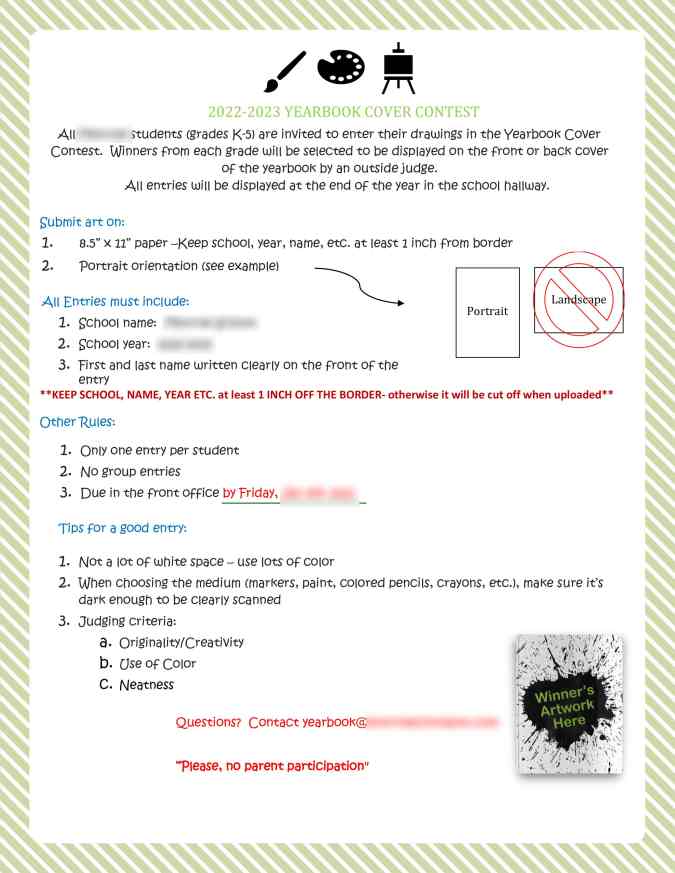
Explain the contest rules in advance to avoid unnecessary tears, hurt feelings, and frustration. Depending on the number of entries received, all can be included in the yearbook. Check out how these schools integrated their runners-up.
Student art on the front and back cover
This is the most popular approach: the winner on the front and runners-up on the back.

Student art throughout the book
Think about it: if you asked students to represent your verbal theme through their submissions, why wouldn’t you use their interpretations throughout the book?
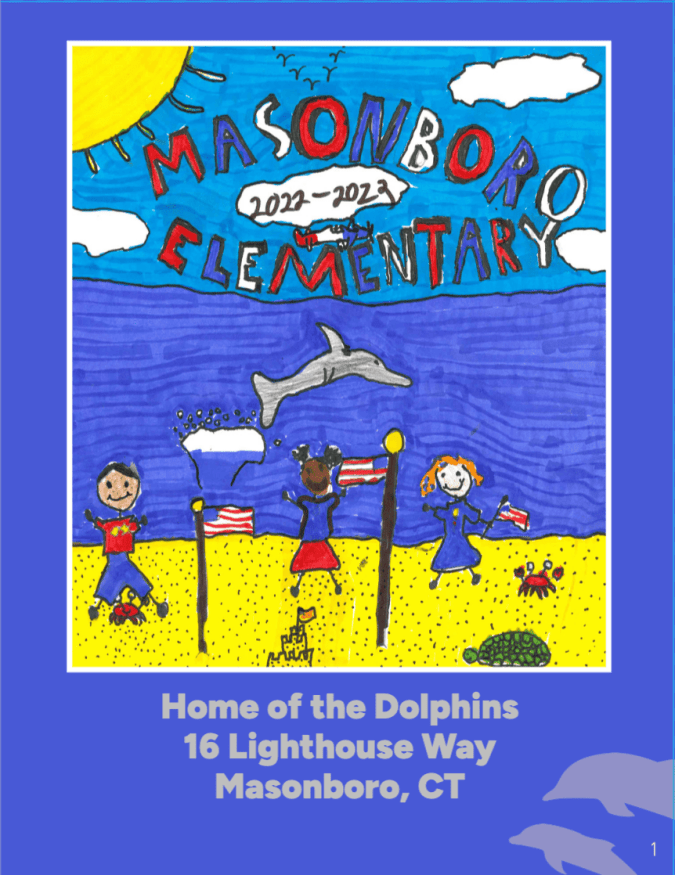

Tag us on social media (Facebook, Instagram, TikTok, X) to show us how you use student talent to foster pride in your school community.
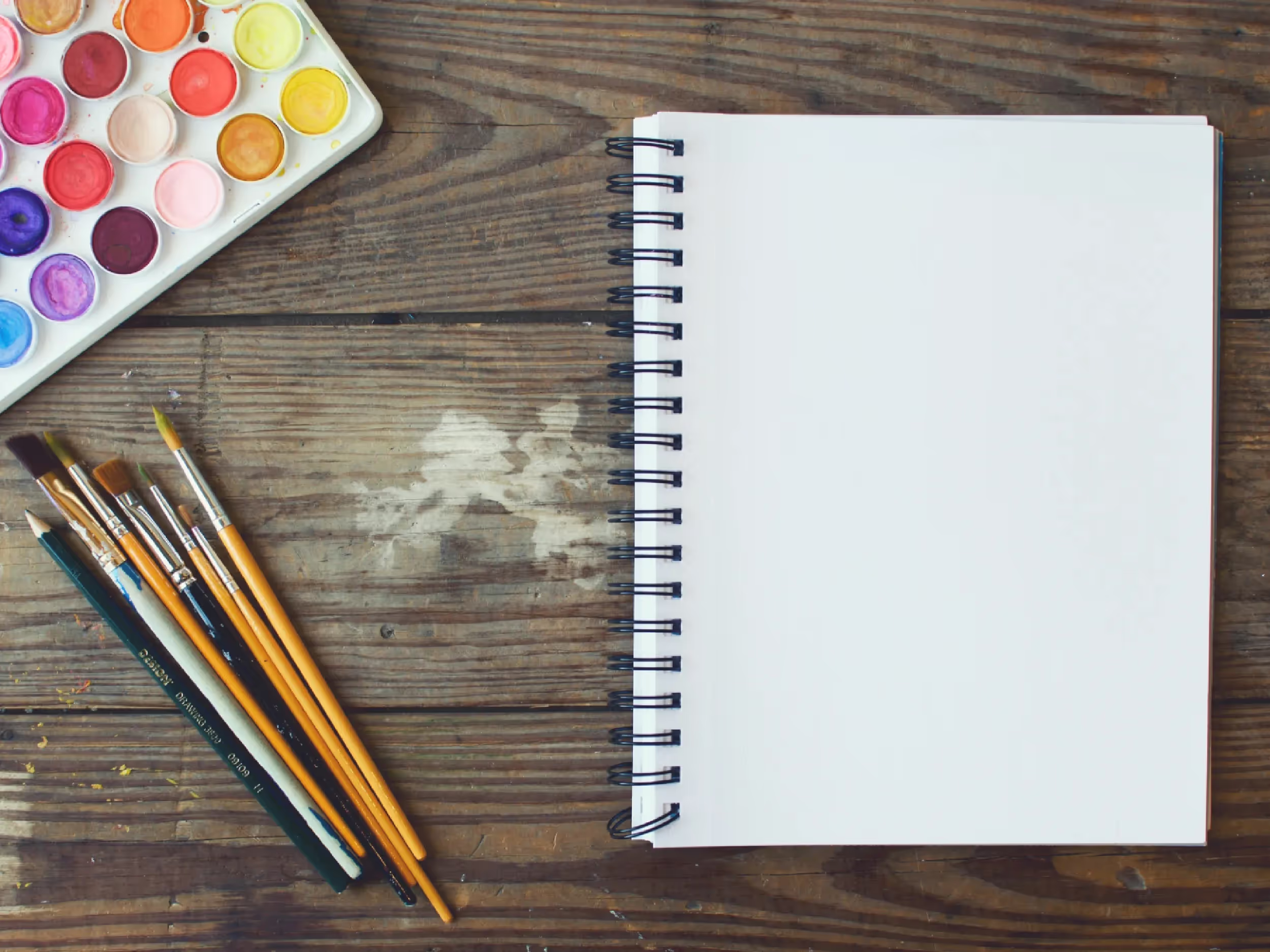
Creating a yearbook style guide
Ever flip through a yearbook and feel like every page was designed by a different person? (Spoiler alert: it probably was.) That’s what happens without a style guide. A yearbook style guide is your rulebook for keeping fonts, colors, and writing consistent so your book feels polished instead of patchwork. It sounds like a design hack, and in reality a yearbok style guide safeguards your theme's brand. Once it’s in place, your yearbook team can stop trying to remember what point the headline font is and get back to creating great coverage.
Wait, what is a yearbook style guide?
Think of it as a playbook and your staff training manual. Your style guide covers two big things:
- Visual theme: fonts, colors, and graphic
- Verbal theme: tone, voice, how you list names and grades
With those basics locked down, your team won’t waste time asking, “Do captions need periods?” or “Which blue are we using again?"
This guide, encompassing design and writing, ensures a unified style while serving as a coaching tool for your team during the layout and design process. Beyond that, it acts as a visionary tool, allowing early development of a creative direction for your book. By providing clear instructions on elements like fonts and colors, the style guide liberates your team to focus on what truly matters, developing coverage ideas, capturing compelling photos and quotes, and crafting stellar layouts. Again, it’s the key to eliminating distractions and letting creativity flourish.
Design: the visual part of your style guide
Often called the visual component of a yearbook theme, design is what people see. Here’s where yearbooks most often go off the rails:
- Fonts
- Color palette
If you’re going to do that, though, you need to cover all your bases and not leave room for interpretation. To do that, focus on locking down font choices, color choices, and how specific aspects of your layouts should look (like whether all photos need captions and, if you have a caption, what that looks like).
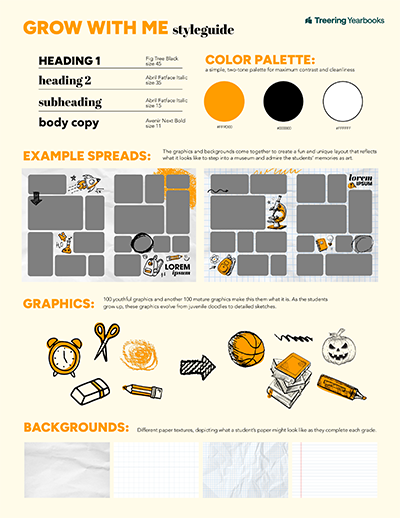
Choosing a Font Palette
With hundreds of fonts from which to choose, resist the temptation to use more than three. Everyone has a preference (#TeamGaramond). Here’s the thing, though. Constantly changing them impacts your readers’ ability to comprehend what’s happening, according to science. Yearbook fonts should complement each other.
When you pick them, define their use:
- Headings and subheadings
- Body copy and captions
- Accents, such as folios, pull quotes
Choosing a Color Palette
Focusing on readability is the first step to choosing font colors. The secondary objective will be using color to enchance the mood of your theme.
If that feels intimidating, using one of Treering’s 300+ themes gives you access to a proven color palette.
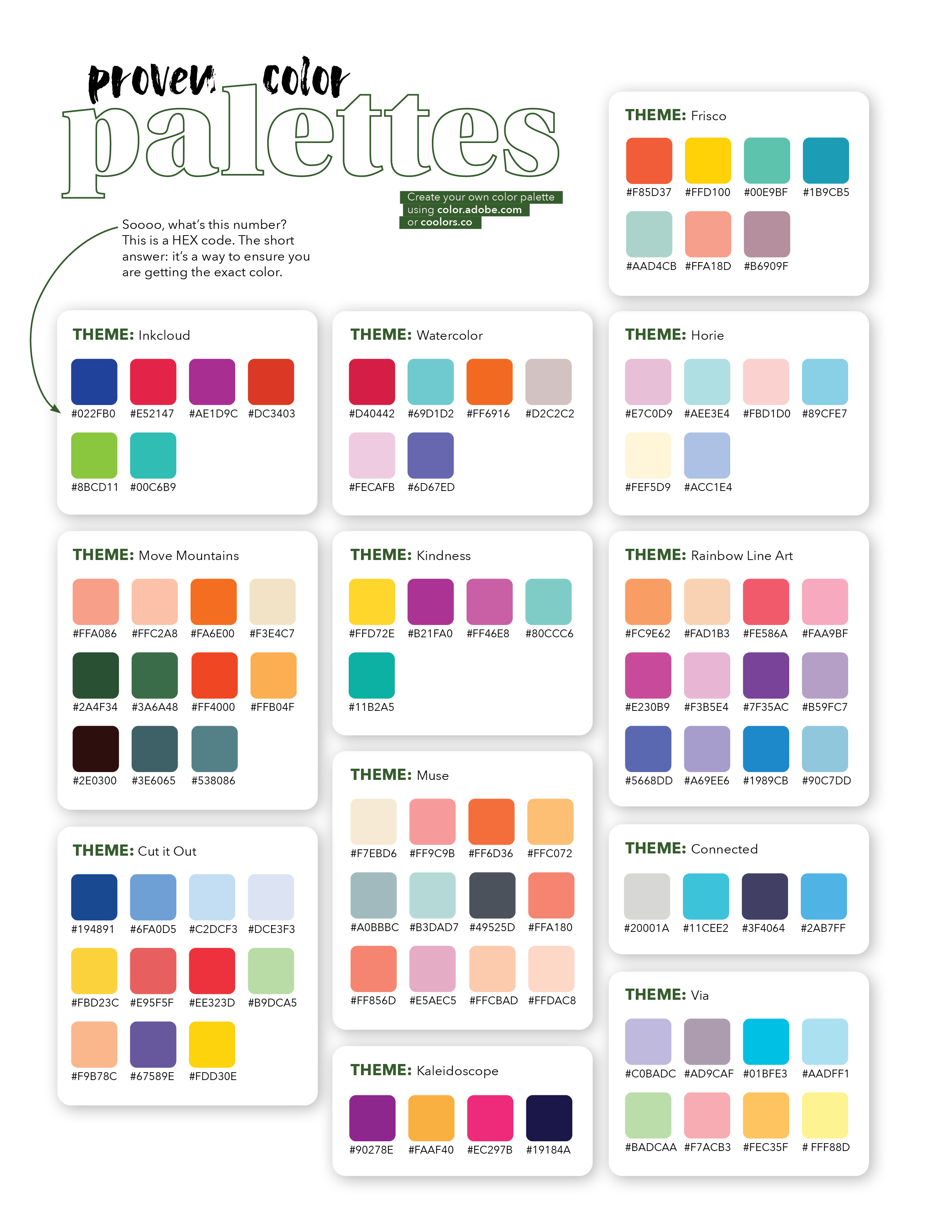
Verbal: the second part of your style guide
Design isn’t the only place things can get messy. Writing needs consistency too. Otherwise, your book will feel disjointed from page to page, like an awkward game of telephone. A few simple rules in your style guide will prevent that.
News sources, including yearbooks, use The AP Stylebook to govern writing mehcanics. Instead of investing excessive hours in an in-house style guide creation, we recommend leveraging the comprehensive AP Stylebook with minimal adjustments for your yearbook.
Instead, focus on tone, voice, using a simple outline. Ensure consistency by reviewing each section of copy against your agreed-upon style.
Tone
How should your yearbook sound? Fun and playful? Serious and academic? Pick one overall mood so your coverage feels intentional.
Voice
Think of voice as personality. Will your headlines be straightforward, such as "Basketball" or a little casual with some humor sprinkled in? Choose a lane and stay there.
Names and grades
Standardize how you list students’ grade levels. For example: Jordan Smith (11), Jordan Smith ’28, or Jordan Smith, a junior. Pick one format and apply it everywhere. These small choices add up to a polished, professional read.
Slang
Be careful here. What feels trendy now might be confusing in a few years, or even alienating to som students reading today. Stick to everyday language unless it’s universally understood.
Spending a few days on your style guide might not feel as exciting as brainstorming cover art or getting set up for photographing the Homecoming Court, but it’s the move that makes everything else easier. A solid style guide locks in your theme, keeps every page visually and verbally connected, and saves your team from endless “which font?” debates. Put in the effort up front, and you’ll walk away with a stronger theme, smoother workflow, and a yearbook that feels intentional from cover to close.

Yearbook examples: why studying sample content is critical (& how to do it)
Some days, you’re so deep into the pages of your yearbook that you can’t figure out how to solve a problem staring you in the face. That’s when you need yearbook examples from other schools.
School yearbook examples can be the single best tool in your arsenal when it comes to helping you solve design problems, find fresh story ideas and layout treatments, and build a library of best practices. It’s one of the reasons Pinterest has become a super-hot resource for yearbook ideas.The problem with Pinterest (and any other “lookbook” approach), though, is that you’re never going to get a full yearbook. And you’re certainly never going to get it in print. Both those factors mean you’re missing out on a lot; namely, context and the ability to easily revisit.
Why not, then, build up a library of yearbook examples from a bunch of other schools? It’s a tried-and-true approach at some of the best school yearbook programs across the country, and it’s really easy to do on your own. You just need to know where to look and who to ask.Inside this post, we’ll walk you through the reasons you should be getting your hands on other schools’ yearbook examples and how you can go about doing it.
Why you should be getting your hands on school yearbook examples
We already hinted at the big reasons for grabbing yearbook samples from other schools, but let’s take a second to make it super clear. You can’t beat having a whole book, in all its context, right in front of you. Think about it: You don’t release your yearbook one spread at a time on Pinterest for your students, do you? Of course not. You give them the whole thing, in all its printed glory, because that’s what the yearbook is all about. Each page and spread builds on the other to create a story of the entire school year. While learning how other schools shape their yearbook’s narrative is reason enough to collect yearbook examples, there are others, too.
Let’s explore a few of them:
- Find new design ideas. It’s a lot easier to have your yearbook team work through design problems and find inspiration when you have some great examples sitting in the same room as with them. And we’re not just talking about spread designs. Other schools’ yearbooks can serve as a way to work through design issues related to everything, including mods, folios, and section breaks—with the added benefit of seeing how those designs complemented theme development, were used as templates throughout the book, etc..
- Spot trends that fit your book. A new yearbook trend seems to pop up every year. Keeping track of them can be hard, and figuring out which ones are best for your yearbook can be even harder. It’s easier to spot them—and know which ones you like—when you have a library full yearbook samples from other schools.
- Identify story angles and themes. You might not know the students featured in other schools’ yearbooks, but that doesn’t matter much. They can still be a goldmine for identifying story angles, themes, and everything else that goes into shaping your yearbook’s narrative. Granted, you won’t use this stuff verbatim, but it’ll help you and your team look at your yearbook a little differently.
- Develop best practices. If you’re lucky enough to collect a bunch of yearbook samples that your team aspires to recreate, you’ve just found the ultimate resource for developing best practices. Gather those books, ask students to find commonalities among key aspects of the yearbook, and list them out. Use that as your guide for creating your own, best-of-the-best yearbook.
- Create new takes on old features. Some features, like table of contents and superlatives, are practically synonymous with the yearbook. But that doesn’t mean they need to be treated like status quo. In fact, a lot of schools have stopped doing that. Using your library of yearbooks as examples, you can find those refreshing approaches and draw inspiration to create your own.
- Practice critiques without hurting feelings. Teaching your yearbook team how to conduct critiques is important, but it’s not always easy when the only yearbook you have on hand is your own. It can be hard to be honest when you’re worried about insulting your friend’s work, and having yearbook samples can ease that tension and give everyone a safe place from which to practice critiques. Do that, and the actual critiques your team does will be that much easier and that much more effective.
If these reasons aren’t enough, well, here’s one more for you: Collecting yearbook examples can connect you with other yearbook advisers, volunteers, and students you would have never otherwise met. Those connections, which could become totally awesome friendships or just people to give you advice and listen to your yearbook problems, can be worth more than any of the other reasons listed above.
How to get yearbook examples from other schools
So, here’s how you can actually get your hands on yearbook samples from other schools:
- PTA/PTSA Meetings: Every PTA and PTSA is full of involved, invested parents. Some even create the yearbook. Start asking around at county-level or regional-level meetings to build yearbook connections and swap books with other schools in your area. Even if the PTA or PTSA doesn’t run the yearbook, they’ll be able to connect you to the person at the school who does.
- Principal Groups: Most principals meet in groups, whether it’s part of a school district’s requirements or a professional development opportunity. Before they go to their next meetup, have your principal ask his or her existing connections to bring a copy of their schools’ yearbooks, so you can have them. It’s an easy way to collect a bunch all at once. (Just be sure to give your principal enough books that he or she can return the favor.)
- State Associations: While most yearbook advisers likely know JEA and NSPA, the national scale of those organizations might be intimidating to some. Instead, look to your local scholastic journalism associations at the state level. These organizations can be less intimidating, and are focused solely on your helping schools in your state. Check out this list to find your state organization.
- Social Media: You’d probably be surprised at how many friends and family can be in a position to help you. And how many other people out there would be willing to help. Put out a request on Facebook or Twitter, and you’re likely to get dozens of offers for help. And don’t forget about LinkedIn. Nearly 6,000 people list themselves there as being elementary, middle, and high school yearbook advisers and volunteers.
Getting great yearbook examples for your yearbook team isn’t hard. You just need to know where to look and who to ask. Start following our tips, and you’ll quickly build a library of books that’ll help you solve design problems, find inspiration, and create a better book overall.
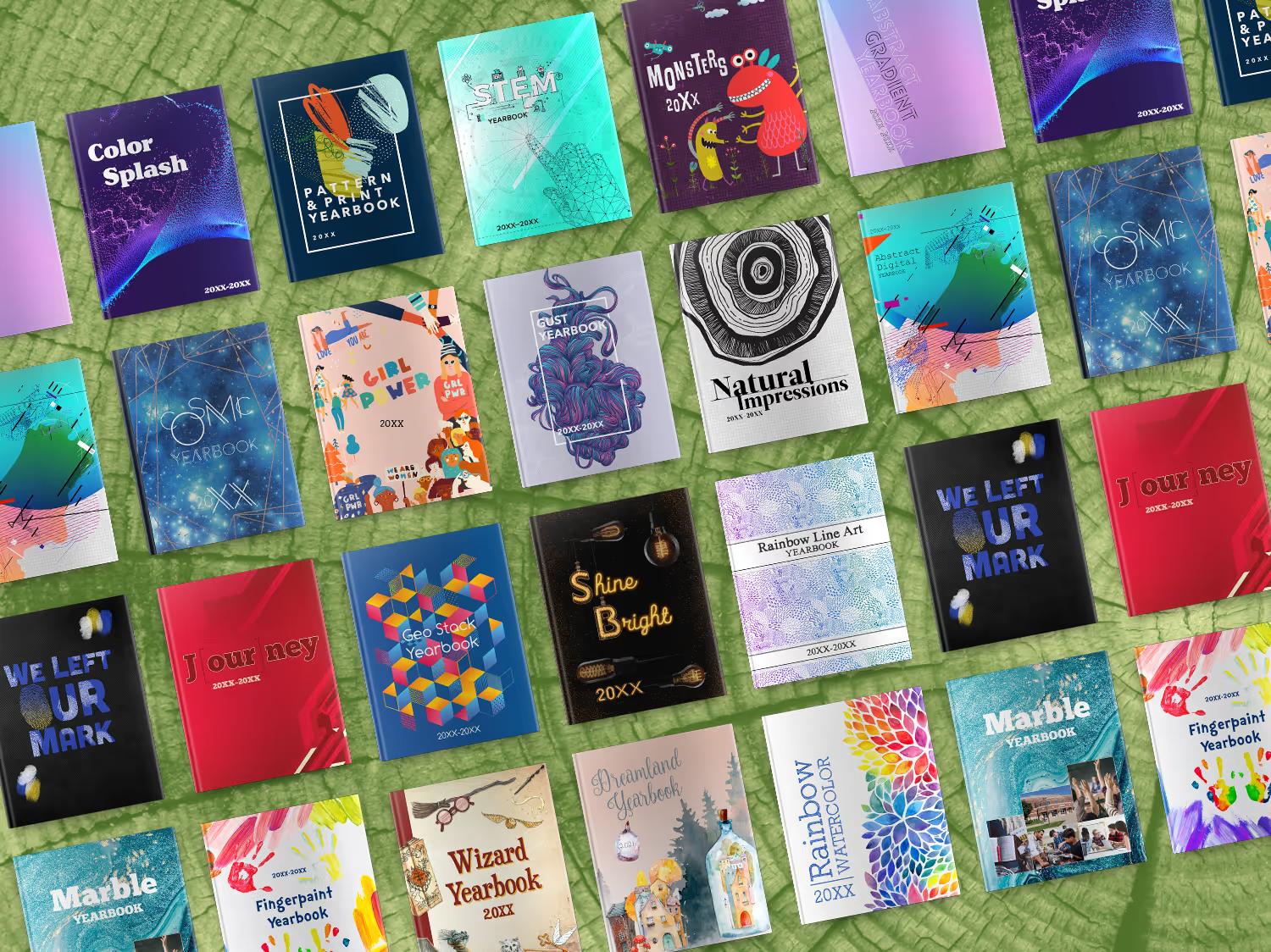
5 tips to help you find your yearbook theme
Whether you're scrambling at the end of the year, or trying to decide at the beginning of the year, coming up with a yearbook theme is tough. How do you come up with the title of a book that hasn’t been written? You can play it safe and gather everyone’s feedback to eventually land on a yearbook theme that everyone hates the least, or you can choose for the group, and face criticism--but no help--for your idea. Let’s be real, neither option sounds fun. I interviewed different yearbook editors to try and gather some advice to help you get started.
Here are 5 questions to ask yourself, followed by 5 thought-provoking theme ideas to inspire creativity.
5 questions:
Why should you run a yearbook cover contest?
Academic goals are of course the primary focus at school, but consider asking the students to layout SMART (specific, measurable, action, reasonable, time) goals at the beginning of the year. Come the end of the year they can go through a self evaluation that will lend itself nicely to the story of your yearbook. Goals could be long or short term. I remember having goals to read a certain number of books throughout the school year as well as trying to make it through a day without doodling on my hands/arms/legs.
What’s popular with your students this year?
From movies to music, snacks to snapchat, pop-culture can be a great way to get some inspiration for your theme. The benefit to using a theme centered on pop culture is it adds an extra layer of nostalgia beyond your photo and story memories. The down-side, well as a child of the ‘80’s I can honestly say the photo of me with 5 foot tall bangs and fanny pack was embarrassing enough, not sure I need to be reminded of the countless hours lost to New Kids and Nintendo.
How are your student’s different from others?
This might seem like a difficult question, but ask your students. They will typically know what makes their school “better” than the rival neighboring school. Growing up most of my classmates lived on a lake, because of this we were all about the water sports. We knew how to waterski off the dock, build pyramids, and wakeboard. We would have loved to see this represented in the theme of our yearbook, as it was unique to our school. You don’t need to limit yourself by the schools colors, the yearbook should tell the story of one moment in time and school colors are not unique to one year.
What issues are student’s passionate about?
Pop culture changes year-over-year and with that children become passionate about different issues facing the world today. Similar to Michael Jackson and Free Willy raising awareness on preserving and protecting the ocean and its inhabitants, today children are talking about climate change and fact checking. Lucky for them they will never understand the frustrations of the card catalog now that Alexa can answer just about all their questions. Consider what issues students are talking about in class and how they are learning to make a positive impact in our future.
Who are your student’s role models?
You might be surprised; kids today are #woke. Gone are the days where Micheal Jordan and Madonna served as the role models of youth. Kids today are looking up to people like Elon Musk and Ruth Bader Ginsberg. They are not just aware of what’s happening in the world, but they are choosing their role models wisely.
Now that you’ve asked yourself a few questions, I thought I’d share some brand new themes that might get you on the road to something truly unique for your yearbook. Below are 5 fresh themes for you to consider for your tribe.
5 theme ideas:
Fingerpaint

This theme captures the spirit of imagination, similar to Harold and his purple crayon, each student has the ability to draw whatever they might need, leaving their unique handprints behind as a reminder of what they have achieved.
STEM
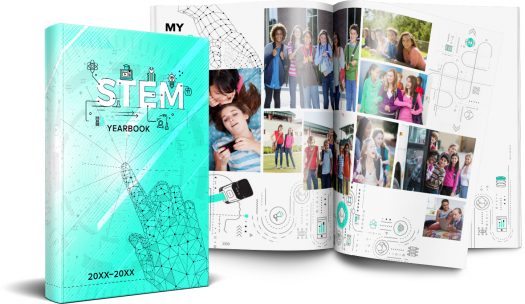
Early learning experiences in Science, Technology, Engineering and Mathematics (STEM) are critical in preparing elementary school students for STEM learning in middle and high school, as well as for future careers in STEM-related fields. This theme talks to more than just the tech culture our children live in, but how schools are more focused now than ever in bringing STEM to the forefront of learning.
J[our]ney

With multiple different color options, this is a classic, bold, choice for a yearbook tribe wanting to add some graphic texture to their book. It’s sentimental in begging the question, “What does the school care about for the year?” There are many ways to play with this theme. Consider some wordplay:
- Y[our] goals
- Enc[our]agement
- N[our]ishment
- Study h[our]
- Y[our] story
Color splash
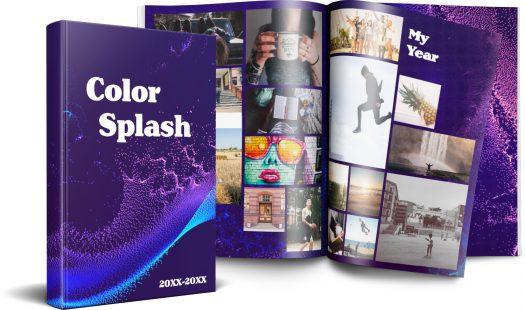
It’s subtle yet elegant in the movement of the dots first flowing together then breaking off to find their own individual path, but not before first making a splash. This yearbook theme would be best for books that are text heavy, given the words will pop on the purple background, and there isn’t a lot of distracting artwork.
Cosmic
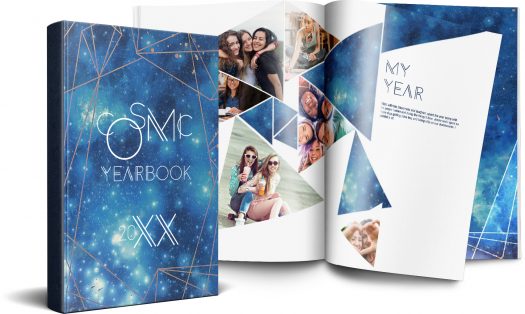
The applications of this theme reach to infinity and beyond. From the single star that shines bright to the entire constellation of stars, our students are pushing the boundaries of learning to their outer limits.Each yearbook tells the story of just one year, whether your theme is how power corrupts, as in J.R.R. Tolkien’s Lord of the Rings, or love and loss as in Nicholas Sparks’ The Notebook, (I genuinely hope those aren’t actually your themes) these ideas should help you get started. If you are looking for more inspiration, check out this handy theme generator, it might get you and your yearbook tribe a bit further on your journey.
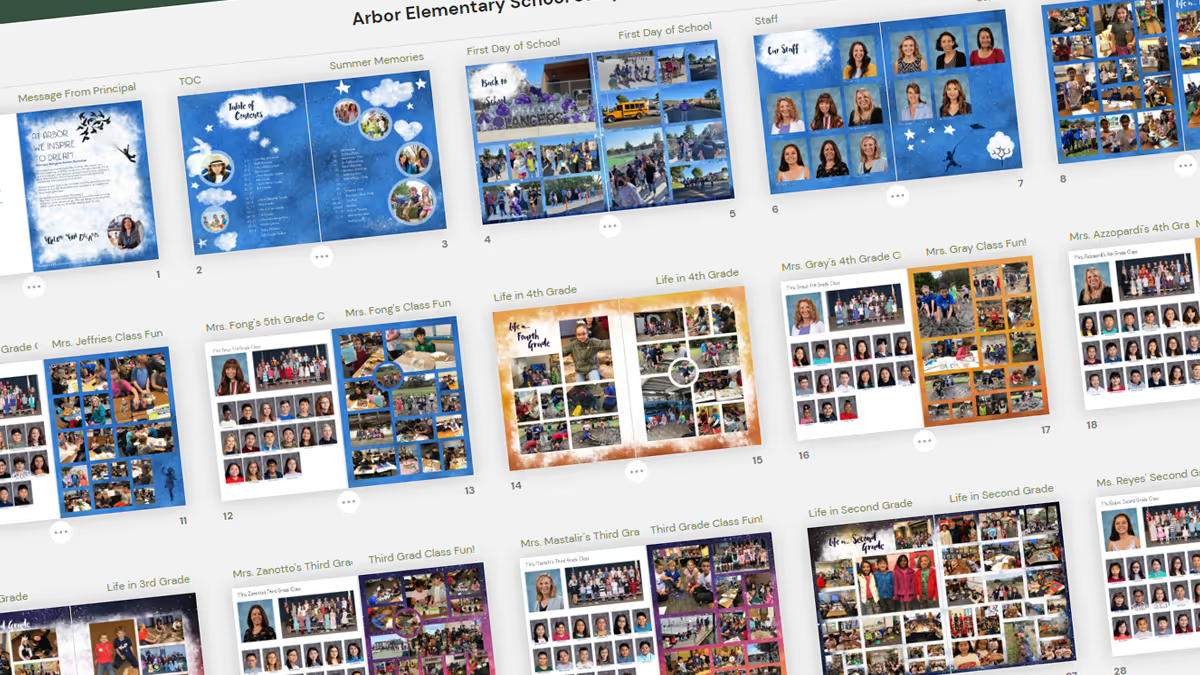
Pages to put in the yearbook
It’s go time: a blank yearbook ladder is in front of you and you need to know which pages to put in the yearbook. Do you take a chronological approach and cover events as they happen? Or should you create a sectional yearbook and handle coverage topically? Did you even know there were options beyond this is what we’ve always done? Below are samples of how other schools have done it and their rationale.
Put your yearbook pages chronologically
Sequoia high school’s yearbook uses 50 of its 148 pages to cover academics, student life, and special events on spreads. The two spreads below show what happened in the month of January and cover the literary food festival, spring musical auditions, lunchtime candids, as well as coursework from economics, Spanish, drafting, logic, yearbook, and graphic design classes. These spreads feature over 40 students and five faculty members.
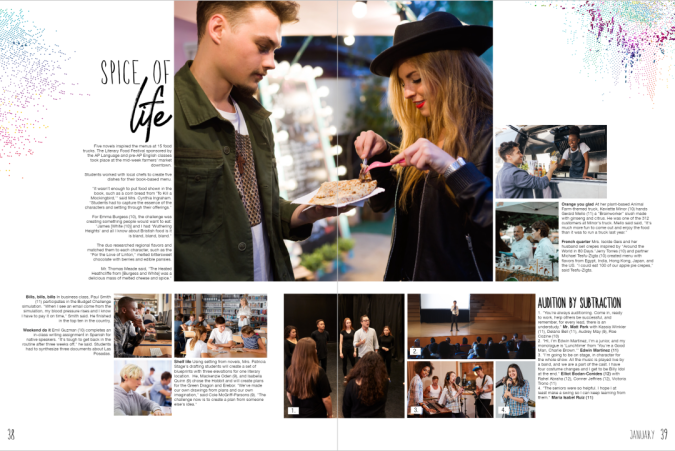
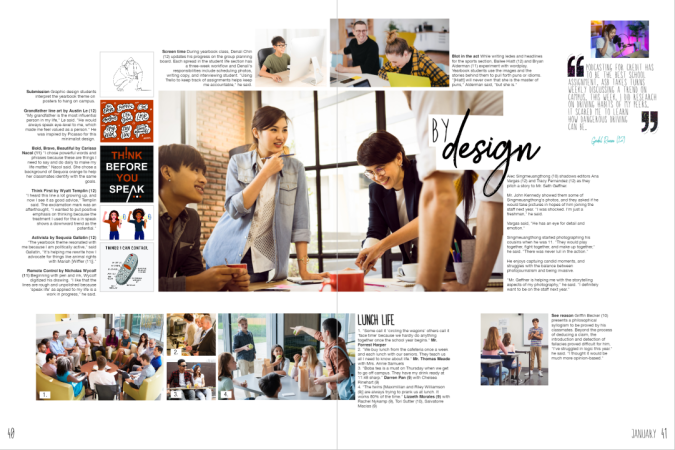
There’s no rule on how to put pages in your yearbook chronologically: we’ve seen schools organize their yearbooks monthly, quarterly, and seasonally. Treering's Seasons of Our Lives yearbook theme makes it easy to put pages chronologically in your yearbook.
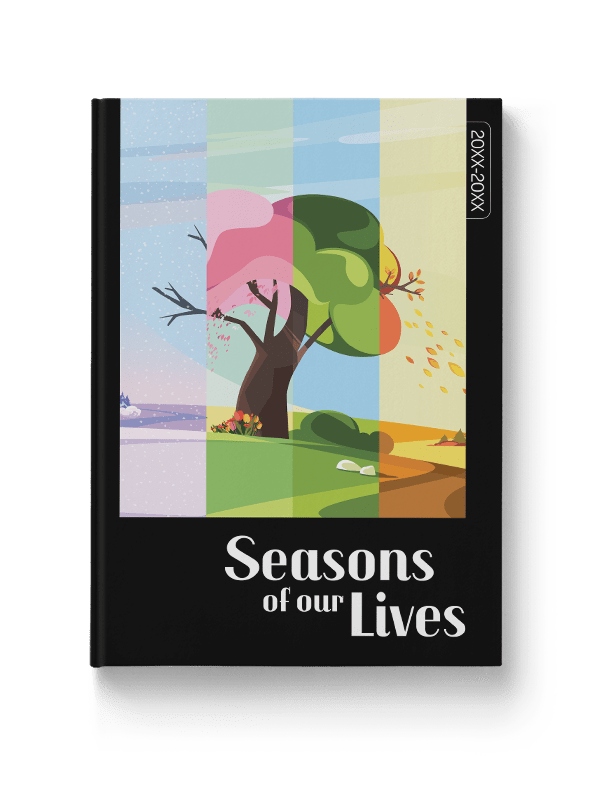
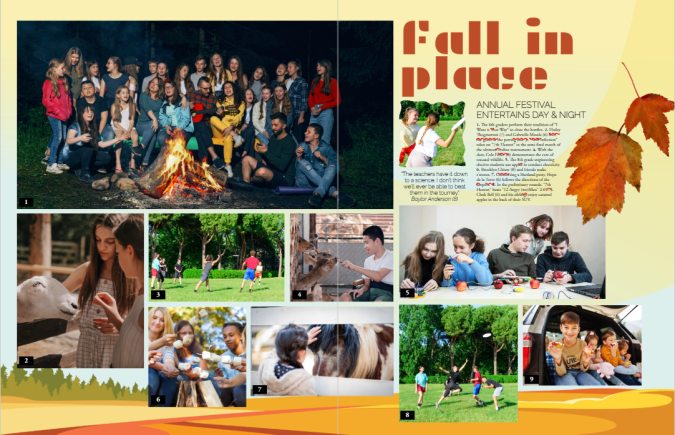
Feeling ambitious? Weekly chronological coverage can be of value to larger or K-12 schools within modules dedicated to academics, club activities and meetings, plus a sporting event of the week.
Chronological cover yearbook coverage helps keep you organized by:
- Structuring your coverage: you can’t cover an event after it’s passed
- Building in mini-deadlines: because you have a structure, you can build due dates and workflows
- Telling the story of the year as it unfolds
Use traditional yearbook sections
Tradition works for a reason. Done right, yearbooks show the complete picture (pun intended) of how students contribute to their communities. It’s a visual reminder of how each story weaves together to become a group narrative. Yearbooks are definitely worth bonding over.
By using sectional, or traditional, coverage to put together your yearbook, pages are placed in topical categories. We know to find Start with Hello in the club section and volleyball in sports.
Traditional sections to put in your yearbook include
People
Student portraits (organized by class, homeroom, or grade), staff, and personality profiles tend to dominate yearbooks. Consider breaking up coverage by adding in siblings, outside-of-school hobbies, and international students.
Student life
All the big, schoolwide moments plus the small distinctive ones (think homecoming, Read Across America, hot cocoa in Mrs. Cruz’s classroom, Dot Day, lawn chair lunches, etc.) make their home in the student life section.
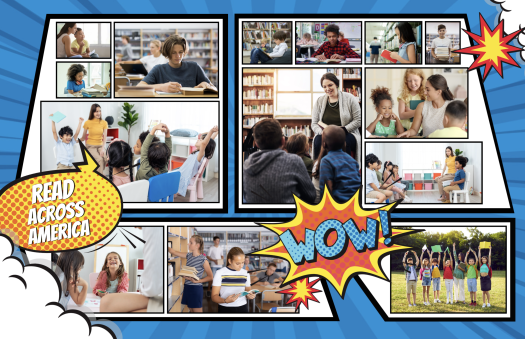
Organizations
Clubs and committees that comprise a large portion of student life may warrant their own section. If most of your clubs are inactive beyond a monthly lunch, consider keeping club activities in the student life portion or feature the group photos in the reference section.
Sports
Remember, action shots have a place, as do club sports, pre-game rituals, and scoreboards.
Academics
If you’re not putting a “Life in…” page, consider grouping academics coverage by grade or subject. Ensure daily classroom activities, as well as holiday parties, are included in the coverage.
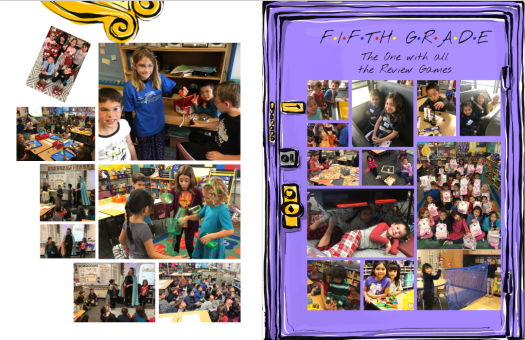
Reference
Put pages devoted to the index, group photos (club and team), and ads in the reference section of the yearbook.
If you need additional inspiration for which pages to put in your yearbook, check out these sample ladders from other schools and adapt them to fit yours.

Yearbook color theory: what it is and how to use it
Color is more than decoration: it’s a communication tool. In a yearbook, color helps reinforce the mood of each section, creates visual hierarchy, and supports your theme. Understanding the basics of color theory enables you to make design choices that are intentional and effective, not just trendy. (If trendy design is your thing, head over to this blog.)

The Color Wheel
I can’t emphasize this enough: color is a complement to content. The right combination can make your theme feel energetic, calm, serious, or playful. Understanding how color affects emotions will affect your readers’ experiences.
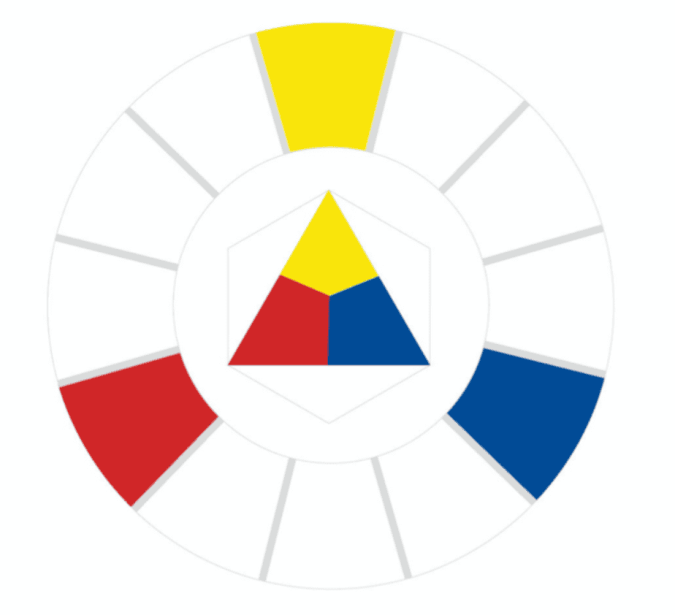
Primary Colors
Red, yellow, and blue are the OG trio. As you learned in elementary school, you can’t make them by mixing other colors, and they can be combined to create every other hue. A section opener with a bold red or yellow background can instantly grab attention—just keep your type simple so it’s still readable.

Secondary Colors
Orange, green, and purple come from mixing two primaries. Secondary colors are a safe way to add contrast to pages without them looking too loud.
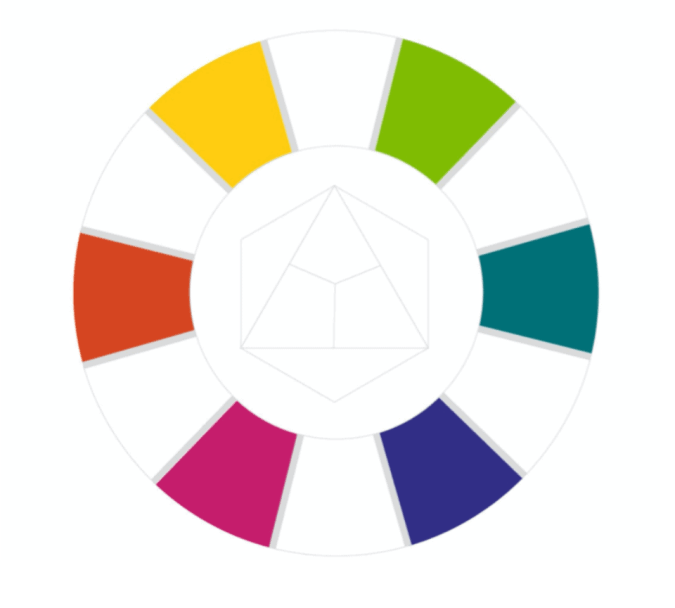
Tertiary Colors
Mix a primary with a neighboring secondary and you’ll get shades like yellow-orange or blue-violet. These in-between shades are perfect for customizing your theme. For example, swap standard blue for blue-green to make a traditional palette feel more modern.
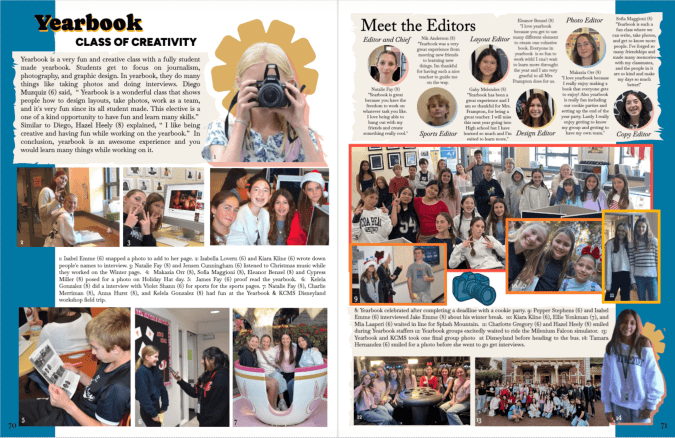
Color Harmony
Color harmony is about choosing combinations that are pleasing to the eye, and useful to you, the designer. Whether you’re creating a visual flow across a spread or building a full-book palette, these harmonies keep your pages cohesive.

Complementary Colors
These are opposites on the color wheel, like blue and orange or red and green. They create strong contrast. Use complementary color accents for headlines, callouts, or graphic elements.
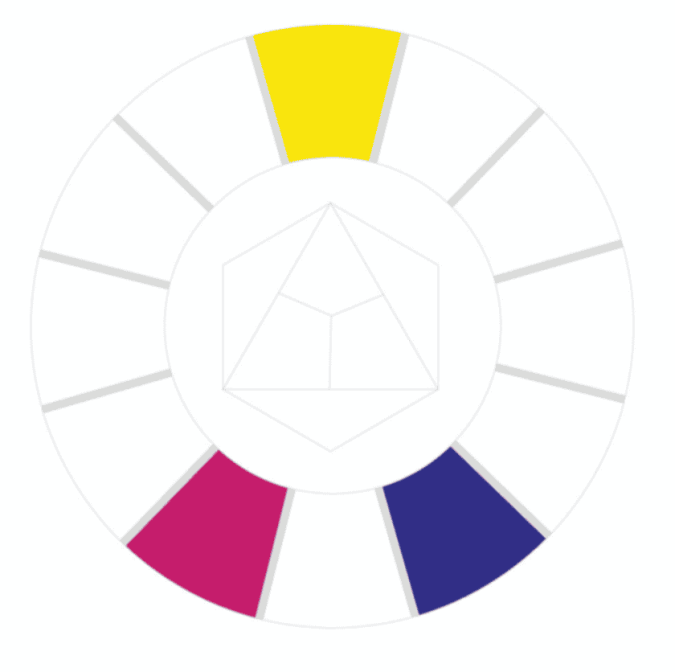
Split Complementary
Choose one color (yellow) and pair it with the two colors next to its opposite (blue). This gives you contrast without tension. For example, if your school color is yellow, balance it with pops of magenta and violet.
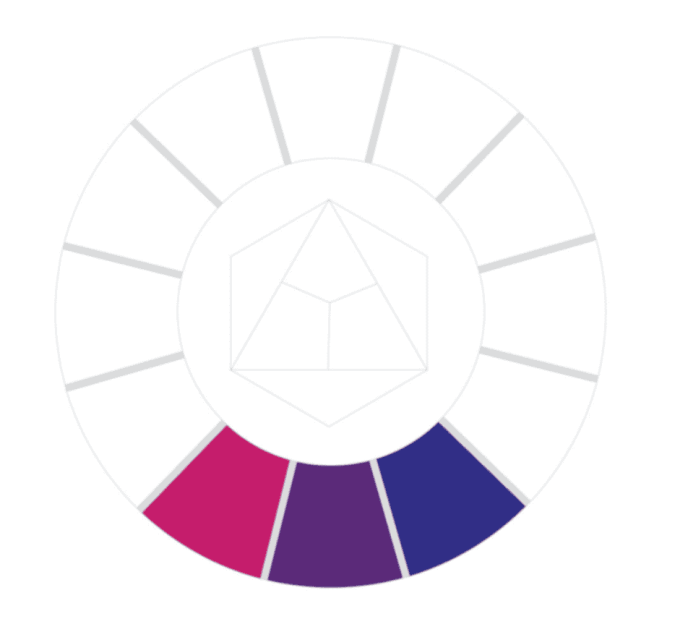
Analogous Colors
These sit next to each other on the wheel and are generally harmonious and soothing. If you’re getting started with color, use an analogous palette to determine your dominant, supporting, and accent colors.
It’s easy to look at these and think you’re limited to three. Using varying tints and shades for value contrast will expand your palette.
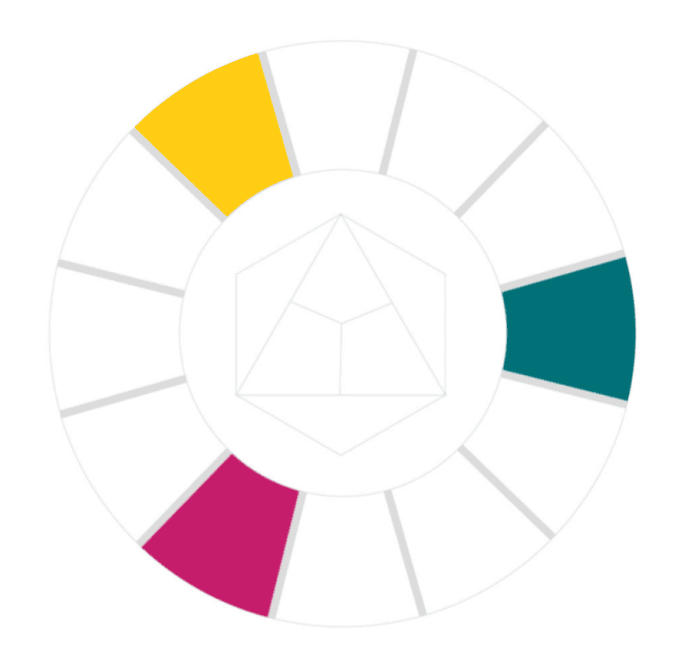
Triadic Colors
Triadic schemes use three evenly spaced colors on the wheel. We see this with the primary colors. Now shift over, you have the ultimate retro palette.
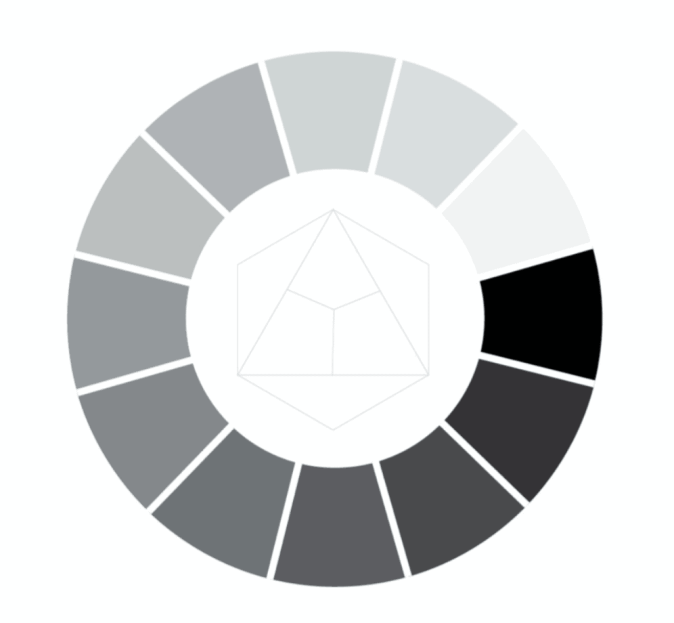
Monochromatic and Grayscale
One color, many values: Monochromatic palettes have so much potential. Purple can have varying degrees of school spirit, while black is sleek and modern. They create contrast, demonstrate intensity, and serve as a base to add accents for emphasis.
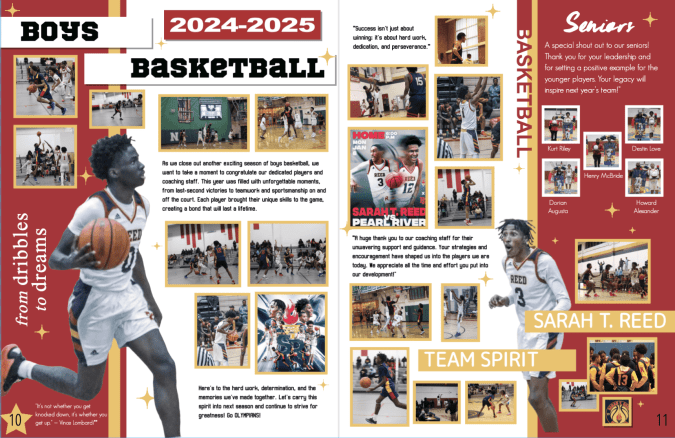
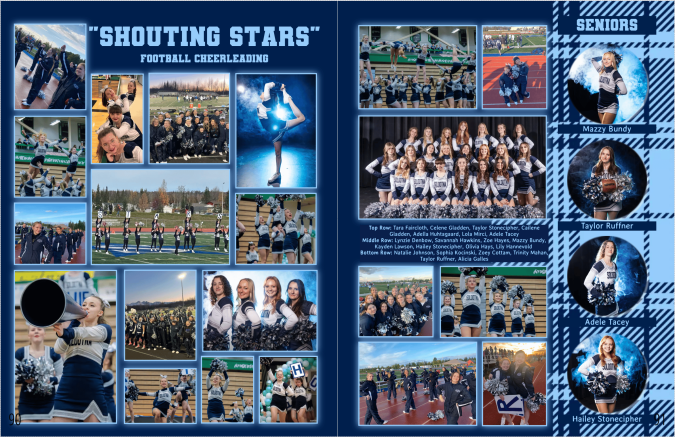
Warm vs. Cool Colors
Warm and cool colors affect how your pages feel emotionally. Look at the two athletic examples above. You can feel the difference. In one, you're sweating with the team and on your feet. In the other, you're maintaining what's left of your voice, sipping cocoa under a blanket with your best friend.
Likewise, use color to determine how the student body will experience your verbal theme.
Putting It All Together
Here’s how to apply color theory to your yearbook:
- Pick a palette early. Choose up to five colors that support your theme and stick with them. Put them in your style guide.
- Use color to organize. You could assign colors to sections, use colors as the backgrounds to modules or pull quotes, or with your headline font to show points of entry.
- Make color intentional. “Don’t decorate… design” is every design teacher’s go-to for a reason. Be intentional and ask, “What mood am I trying to create?” “What color harmony supports that?” “Why isn’t this working?”
- Check accessibility. Make sure the text has enough contrast from its background.
- Balance bold and neutral. Too much color can overwhelm. Whitespace will always be your friend.
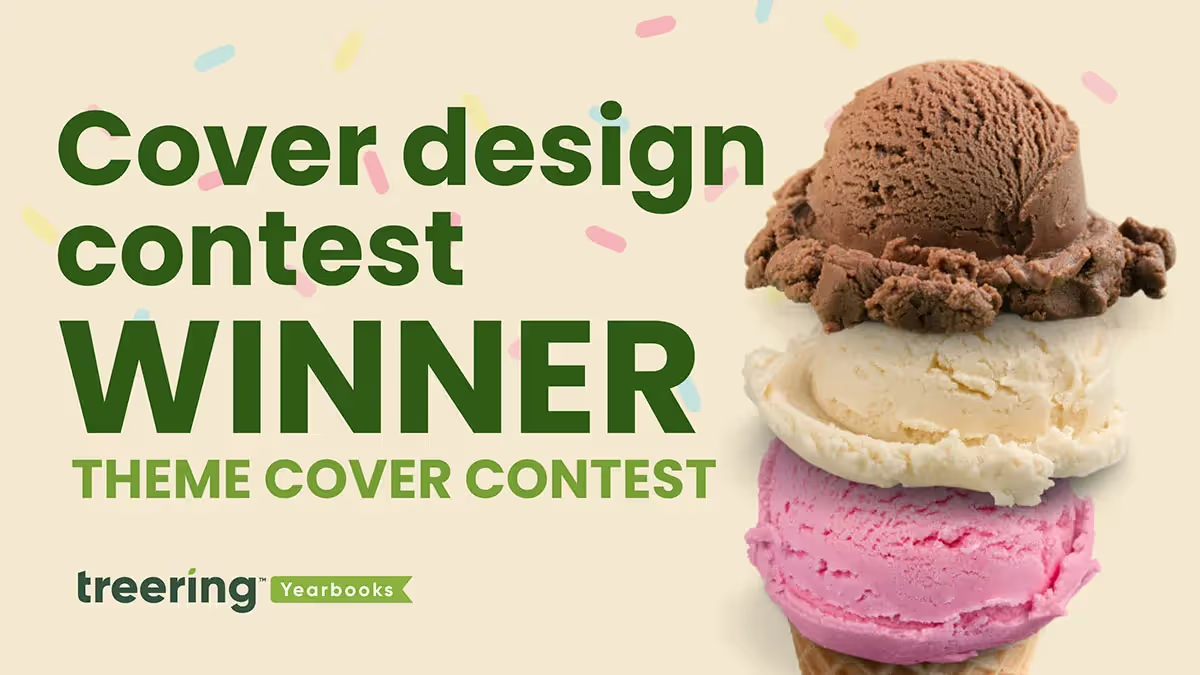
2025 Theme cover winners
In Treering’s inaugural Cover Design Contest, which—if we’re being real—was three concurrent contests, schools submitted their covers to one of three categories:
- School Spirit – mascots, school colors, and anything else that shows off your community
- Theme Development – an introduction to your visual and verbal theme
- Elementary Student Art – original art by K-6 students
Our team explored over 300 submissions, and the ones that stood out introduced their theme on the front and back cover, then expanded it inside throughout the book. Each of the themes below are specific to the time and place in which they exist. While the concept may work for the school across town, the execution would not.
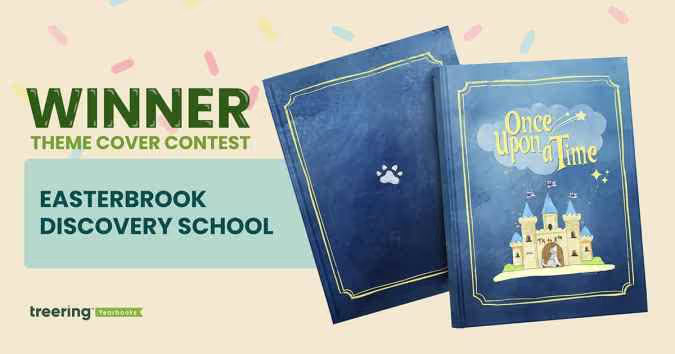
Grand Prize Winner: Easterbrook Discovery School, San Jose, CA
Theme: Once Upon a Time
This year was extra special. It’s EDS’ 20th anniversary and the tenth year in its building. These once in a lifetime moments became an obvious connection for the yearbook theme.
Pre-pandemic, a middle school yearbook club produced the book. The PTO wanted to continue to showcase student perspectives with a cover contest. “It celebrates creativity, individuality, and the shared ownership that makes our yearbook and our school so special,” said Bai-Lim.
This year, they gave little guidance: “Your design should relate to the ‘Once Upon a Time’ theme (e.g. fairy tales, dragons, fairies, wizards, enchanted creatures, etc.).” The faculty and staff chose the winning cover in an anonymous vote.
Winner Helena Kao created a design rich in symbolism:
- Castle: community, teachers, and parents that made our school a story worth telling
- Bricks: depicted fundraisers, music concerts, and field trips that were the building blocks to a safe and welcoming space for students to learn and grow
- Flags: the husky spirit that defines EDS
- Closed door: an end of a chapter for the graduating class of 2025
- Howling Husky: singing and celebrating the school it proudly represents
The cover art contest led to another “once” moment: ninety pieces of student art throughout the yearbook. “Each piece felt like part of the story of the school year,” said Bai-Lim, “and we didn’t want to leave that out.”
Bai-Lim’s team used a Treering vintage blue background, various story-inspired borders, and the lunchbox font for titles. She said, “Treering made it so easy to bring our ideas to life.”
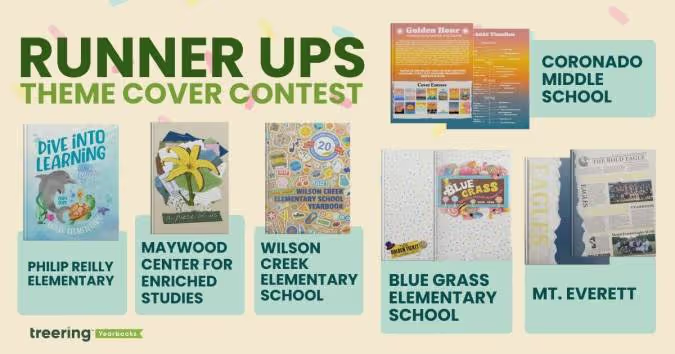
The Final Five Six
Blue Grass Elementary School, Knoxville, TN
Theme: A School of Pure Imagination
The sweet cover made us melt. (It’s a contest for a back to school ice cream bash with cool puns, how could we not go there?) What’s more, is the yearbook theme and the school’s theme were one.
The team at Blue Grass used “a school of pure imagination” to guide their year. It was a “perfect match for capturing the magic, curiosity, and creativity that define our school community,” yearbook chair Becky O’Hatnick said.
She and her team of parent volunteers sprinkled each page with “candy-colored hues” and created titles on candy wrappers and golden tickets.
“From cover to cover, our yearbook is a vibrant celebration of childhood wonder and the boundless possibilities of imagination,” O’Hatnick said.
Coronado Middle School, Coronado, CA
Theme: Golden Hour
This coastal school embraced their SoCal vibe by using the colors of the golden hour to progress through the book. The students studied the sun, and used it for theme copy: “At the end of each day, and each Golden Hour, the sun must set. This is an opportunity to begin anew, never forgetting the last chapter, but anticipating the beauty of the next.”
“The edges of the book had a gradient,” adviser Heidi Frampton said, “so that as you flipped through the book you would see the sunset colors.”
Maywood Center for Enriched Studies, Maywood, CA
Theme: A Piece of Us
Every single one of us has a mosaic of experiences that makes us who we are,” adviser Nora Torres said. Her team built on that concept by piecing together textures and colors to create the layered cover. The more you look at it, the more details emerge.
They brought their theme into the book by using graphic pieces, such as scrap paper, tape, and cut-out letters to accent the content. Divider pages, especially, looked as if they were hand-designed. To make it even more personal, the yearbook staff added “yerd* doodles” throughout the book.

*Yerd = yearbook nerd
Mt. Everett Regional School, Sheffield, MA
Theme: Ripping Through Tradition
Students chose to blend nostalgia and tech by using newspaper graphics at an angle to chronicle their year. It’s a “blend of past, present, and future,” said adviser Kari Giordano.
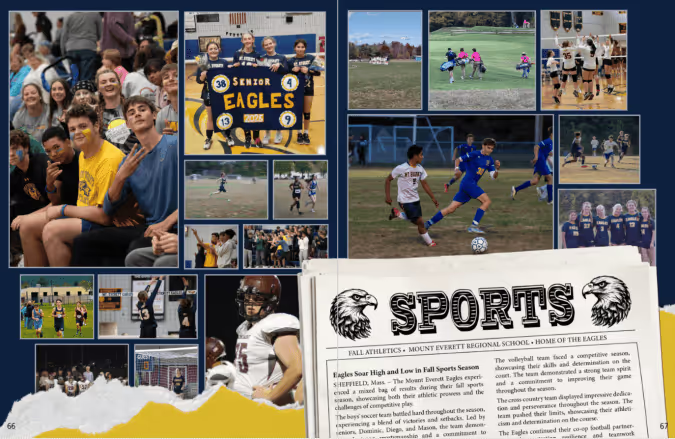
“This theme visually represented the senior class ‘shredding expectations,’” said Giordano, “and boldly stepping into the next phase of their lives.”
Philip Reilly Elementary, Mission Viejo, CA
Theme: Dive Into Learning
Yearbook chair Kristin Keller said she “created an underwater world where our theme could truly swim.”
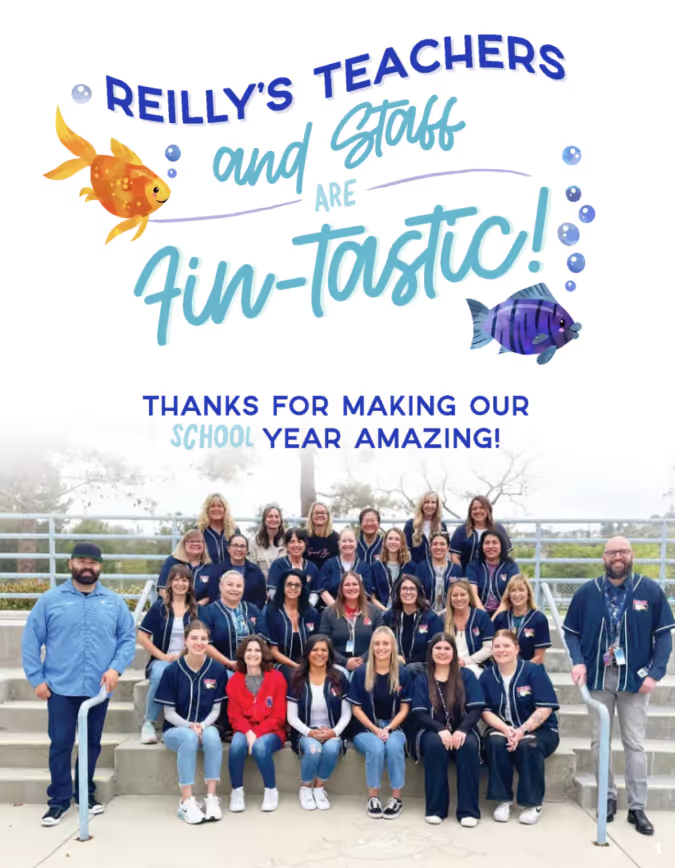
From using circular photos as bubbles to adding sea-sational puns, her designs were focused. Keller used design hierarchy and contrast to keep each afloat in a sea of color.
Wilson Creek Elementary School, Duluth, GA
Theme: Wildcats Stick Together
At first glance, this cover was familiar. Then, we looked closer.
“This hybrid theme enhances the Treering-designed theme ‘Stick Together’ with totally unique Wilson Creek graphics and vibes that show off how Wilson Creek Wildcats learn, live, and laugh,” said yearbook co-chair Holly McCallum.
She designed the sticker pack to include interactions of the wildcat, WCES, and their anniversary crest. The brown paper background takes us back to the first day of school, when you’d cover your textbooks with grocery sacks. Considering this is Wilson Creek’s 20th anniversary, it’s an emotive design decision.
McCallum also added frames to photos to make them look like stickers and she added positive messages “to emphasize the creative spirit and collaborative dynamic” of her school community.
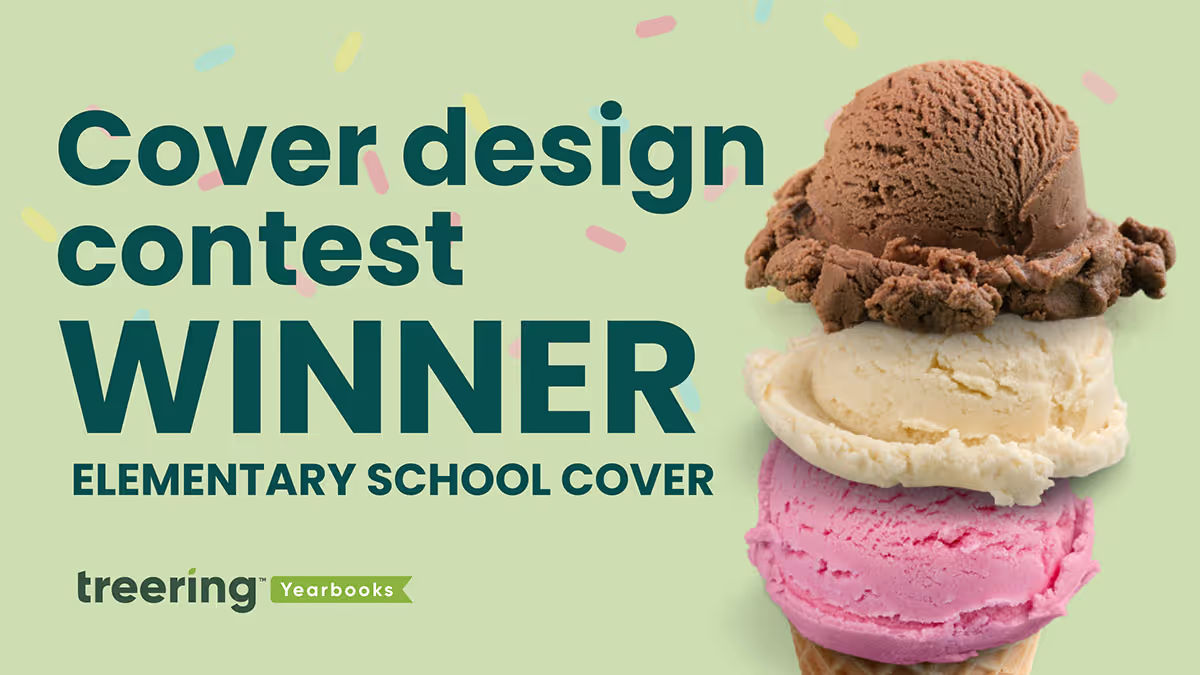
2025 Elementary student art cover winners
In Treering’s inaugural Cover Design Contest, which—if we’re being real—was three concurrent contests, schools submitted their covers to one of three categories:
- School Spirit – mascots, school colors, and anything else that shows off your community
- Theme Development – an introduction to your visual and verbal theme
- Elementary Student Art – original art by K-6 students
Students created original yearbook covers using paint, AI, colored pencils, crayons, mixed media, digital media, and pen and ink. Yearbook committees gave prompts that were open-ended, fixed, and everything in between. While many submissions were the result of a yearbook cover art contest, others were collaborative projects. All were steeped in the tradition of promoting student perspectives and community.

Grand Prize Winner: Peace Valley Charter School, Boise, ID
“Waldorf schools instill a deep respect for the natural world, fellow human beings, and the spiritual elements in all beings,” said 6th-grade teacher Nichole Murray, whose students compete annually in the yearbook cover contest.
Murray, PCVS dad Jason Ropp, and yearbook coordinator Gigi Murfitt display the entries in the hallways so all students can see them and begin to dream ahead for their chance in the cover contest. PCVS teachers choose the winners, and first and second place go on the outside cover. All cover contest submissions appear inside the book.
“The elements of nature are expressed, and our mascot, the otter, symbolizes intelligence, playfulness, resilience, and adaptability,” they said.
Both art pieces caught the judges' attention because they used similar colors and exceptional lighting–one judge kept exclaiming, “The shadows!”
The. Shadows.
The cover art introduces outsiders to the Waldorf philosophy, especially how the art curriculum helps nurture imagination, emotional intelligence, and a well-rounded intellect.
“Our mascot, the otter, symbolizes intelligence, playfulness, resilience, and adaptability,” Murray said.
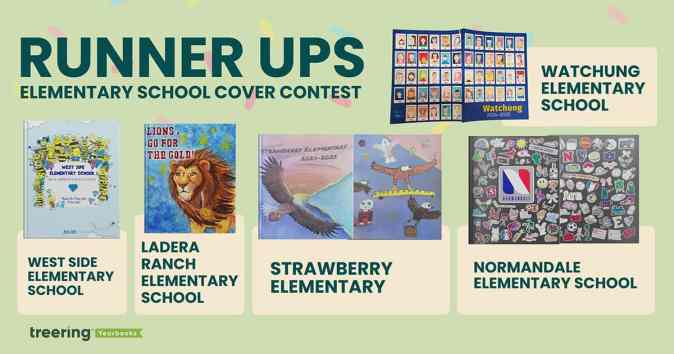
The Final Five
Ladera Ranch Elementary School, Ladera Ranch, CA
Fifth grader Fiona Martin captivated us with the color explosion and detail on her cover design. PTA president Joya Celik said the yearbook team at LRES asked the students to create a design incorporating their mascot “that reflected courage, perseverance, and attaining [their] goals.”
Their 2024-2025 school theme was “Go for the Gold.” Martin surely did just that.
Normandale Elementary School, Edina, MN
Yearbook team leads Lauren Dickerson and Becky Sertich created a collaborative project for 5th-grade students. Taking their inspiration from water bottles, Chromebooks, and everything else tweens touch, they asked students to create their own “sticker” design.
They “scanned and edited [each submission] to add a white border (like a sticker) and to make the background transparent so the ‘stickers’ could be arranged on the cover like clip-art.”
The result? An on-trend, completely original yearbook cover that shows the personalities and priorities of promoting students.
Strawberry Elementary, Santa Rosa, CA
This one is also collaborative: the front and back covers are creations from 6th graders and the local high school (shout out Sonoma Academy in Santa Rosa) helped put it all together. The latter used AI design tools to expand the front cover art to wrap around to the back. On the back, they also created a composite of art.
“The high school students had originally envisioned a variety of student strawberries in the grass and eagles in the sky for this cover design,” yearbook coordinator Pamela Vincent said. “But [a] 6th grade student convinced them that one of the eagles could be arranged to carry a strawberry-filled basket.”
“In total, seven high school students and 11 elementary school students collaborated to make this cover a reality,” Vincent said.
Watchung Elementary School, Middlesex, NJ
Wrap-around cover, check. Multiple students’ art, check. This cover ticked all the boxes, and once we learned about the five-week process to create each self-portrait, we were even more in awe of what a PK-3 school produced.
“Students are placed in Polaroid frames to remind the third graders that no matter how much time goes by, their 3rd grade memories will remain the same,” Librarian Anne Erchicks said.
West Side Elementary School, Marietta, GA
The team at WSES made their 75th anniversary book an homage to late Principal Reid Brown's first yearbook theme. To convey “Shine Bright like a Diamond and Be the Best Bee You Can Be,” each student from kindergarten through 5th grade created their own bee and drew a diamond.
“Our yearbook team voted on using student art as the cover,” said yearbook coordinator Shelley Strack. “We also used the additional bees and diamonds throughout the yearbook as graphics.”
Strack and her team created contemporary art to celebrate Brown’s message. “I loved the use of new and old as a part of our yearbook,” she said.
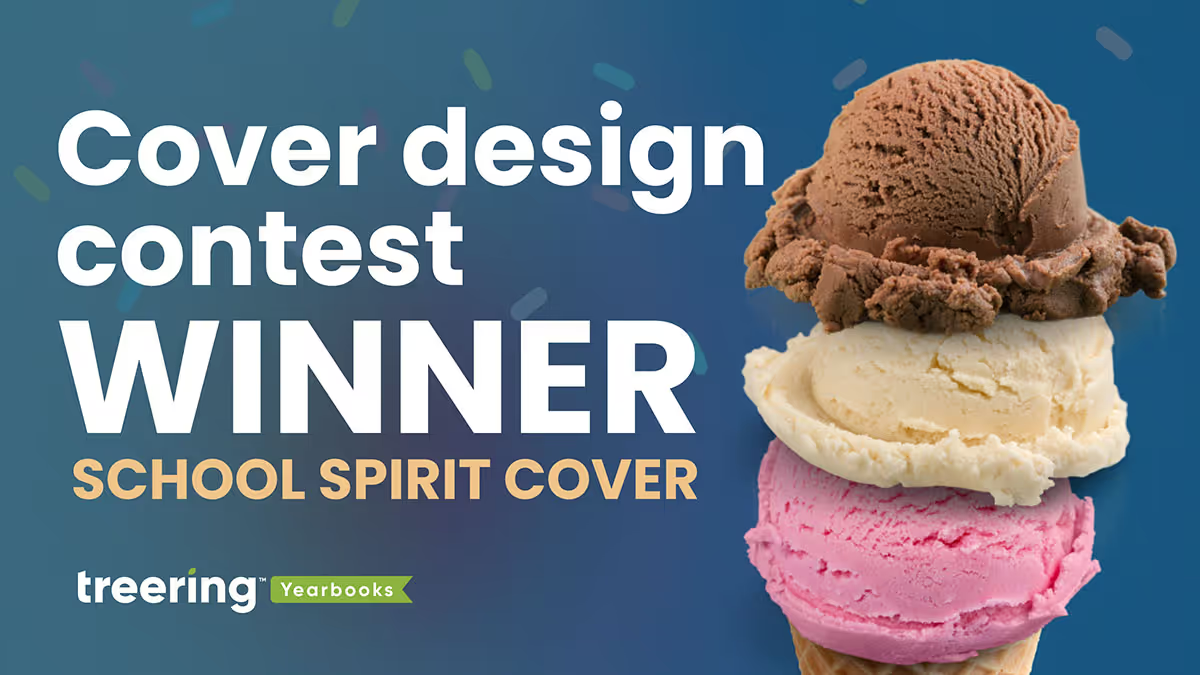
2025 School spirit cover winners
In Treering’s inaugural Cover Design Contest, which—if we’re being real—was three concurrent contests, schools submitted their covers to one of three categories:
- School Spirit – mascots, school colors, and anything else that shows off your community
- Theme Development – an introduction to your visual and verbal theme
- Elementary Student Art – original art by K-6 students
We said, “School,” you said, “Spirit.” Pride in your community shone through on every cover.
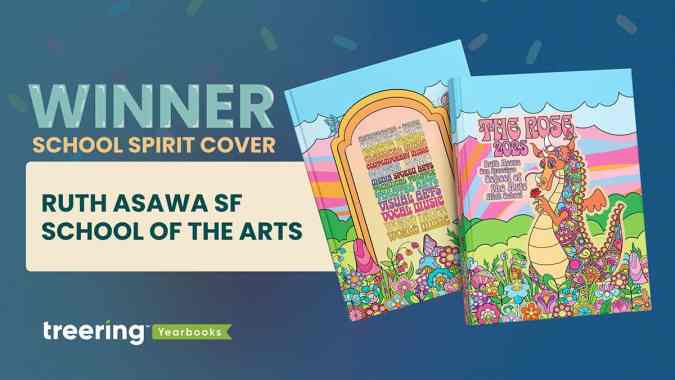
Grand Prize Winner: Ruth Asawa San Francisco School of the Arts, San Francisco, CA
Mascot: Rainbow dragon
School colors: 15 colors representing 15 art departments
“Each of the dragon's colors represents one of the school's 15 arts departments. Those colors are carried through the rest of the design, appearing in the colorful garden that spans the bottom of the front and back cover, and in the text on the back cover where each department's name is written in its unique color,” said adviser Jeff Castleman, who also teaches drawing, painting, photography, and computer art.
This cover illustrates the adage, “Know the [design] rules, and break them.” Generally, we’d encourage a yearbook creator to avoid using 15 colors. Not Asawa Arts.
They grouped warm colors for the sunset-inspired swirls, sandwiched between greens as grasses and blues in the skies. Each piece of flora has the base of the blues or pinks with pops of contrasting colors. Black lines hem it in.
A group of eight yearbook club students collaborated on the original illustration. The lead designers, both seniors, at Asawa Arts’ yearbook club developed the visual identity of the yearbook. They went from pencil sketches to creating their own computer-based line art. Six supporting designers (all juniors) filled it in with flowers, leaves, mushrooms, and butterflies.
On the spine and in the dragon’s hands are roses. “The rainbow dragon symbolizes our school spirit,” Castleman said, “and the rose it holds represents our guiding principles.”
The acronym representing Respect, Openness, Safety, and Engagement is part of the campus as much as it is part of the culture.
Castleman appreciated the flexibility of working with his students to create the vision and fully customize the yearbook cover. He said each year, the yearbook team re-imagines the dragon, giving it a different feel, from East Asian and Medieval to this year’s psychedelic interpretation.
“We think of [the cover] as the crowning jewel on a bespoke book,” Castleman said.
Castleman's team earned a Treering-sponsored back-to-school ice cream bash for their campus.
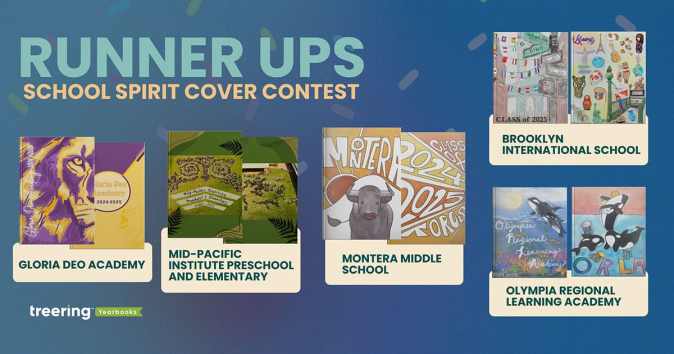
The Final Five
Brooklyn International School, Brooklyn, NY
Mascot: none
“Our school is a very tight community as our students come from many backgrounds trying to achieve the American Dream, but not forgetting their roots,” Norma Gaytan said.
Gaytan’s students represented their classmates with flags and artifacts from their home countries.
Gloria Deo Academy, Springfield, MO
Mascot: Lion
This is the cover we expected: school colors and a mascot boldly proclaiming school spirit. The texture in the mane and near-watermark incarnations of the lion on the back adds texture.
Mid-Pacific Institute Preschool and Elementary, Honolulu, HI
Mascot: Pueo (Hawaiian Owl)
The drone photo in honor of Mid-Pacific’s 20th anniversary is impressive enough. We loved the before and after images.
Adviser Abbey said, “The students learned about how to use a grid to scale an image, practicing in art. We then applied the math to create a giant grid on our courtyard and replicated our school mascot with field paint.”
Montera Middle School, Oakland, CA
Mascot: Toro
Student art always holds a special place in our hearts. Montera’s cover art extended from the front to the back cover, making a bold statement of school spirit.
Olympia Regional Learning Academy, Olympia, WA
Mascot: Orca
The symbolism in the student art evokes powerful sentiments of school spirit. Both contest winners captured the essence of the K-12 campus’ mentoring ethos. On the front, a mother and baby orca represent the cooperative role ORLA provides.
“We take our cooperative role with the families very seriously and we could not have the kind of school or kind of students we have without the role the caregivers provide, both at home and at our school,” adviser Rachel McKaughan said.
“The back cover also represents the playful spirit we have at the school with our many hands-on electives, she said, “where students are able to discover and express many different talents.”
From each submission, we learned school spirit is more than a sports team or school song steeped in tradition. It is comprised of community features: shared values and overarching identity. Thank you to the 300+ schools that shared their story with us.
